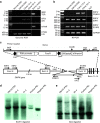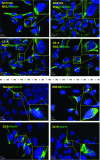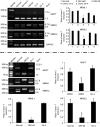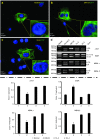Genome Therapy of Myotonic Dystrophy Type 1 iPS Cells for Development of Autologous Stem Cell Therapy
- PMID: 27203440
- PMCID: PMC5023370
- DOI: 10.1038/mt.2016.97
Genome Therapy of Myotonic Dystrophy Type 1 iPS Cells for Development of Autologous Stem Cell Therapy
Abstract
Myotonic dystrophy type 1 (DM1) is caused by expanded Cytosine-Thymine-Guanine (CTG) repeats in the 3'-untranslated region (3' UTR) of the Dystrophia myotonica protein kinase (DMPK) gene, for which there is no effective therapy. The objective of this study is to develop genome therapy in human DM1 induced pluripotent stem (iPS) cells to eliminate mutant transcripts and reverse the phenotypes for developing autologous stem cell therapy. The general approach involves targeted insertion of polyA signals (PASs) upstream of DMPK CTG repeats, which will lead to premature termination of transcription and elimination of toxic mutant transcripts. Insertion of PASs was mediated by homologous recombination triggered by site-specific transcription activator-like effector nuclease (TALEN)-induced double-strand break. We found genome-treated DM1 iPS cells continue to maintain pluripotency. The insertion of PASs led to elimination of mutant transcripts and complete disappearance of nuclear RNA foci and reversal of aberrant splicing in linear-differentiated neural stem cells, cardiomyocytes, and teratoma tissues. In conclusion, genome therapy by insertion of PASs upstream of the expanded DMPK CTG repeats prevented the production of toxic mutant transcripts and reversal of phenotypes in DM1 iPS cells and their progeny. These genetically-treated iPS cells will have broad clinical application in developing autologous stem cell therapy for DM1.
Figures







Similar articles
-
Genome modification leads to phenotype reversal in human myotonic dystrophy type 1 induced pluripotent stem cell-derived neural stem cells.Stem Cells. 2015 Jun;33(6):1829-38. doi: 10.1002/stem.1970. Stem Cells. 2015. PMID: 25702800 Free PMC article.
-
Therapeutic Genome Editing for Myotonic Dystrophy Type 1 Using CRISPR/Cas9.Mol Ther. 2018 Nov 7;26(11):2617-2630. doi: 10.1016/j.ymthe.2018.09.003. Epub 2018 Sep 11. Mol Ther. 2018. PMID: 30274788 Free PMC article.
-
Genome Editing of Expanded CTG Repeats within the Human DMPK Gene Reduces Nuclear RNA Foci in the Muscle of DM1 Mice.Mol Ther. 2019 Aug 7;27(8):1372-1388. doi: 10.1016/j.ymthe.2019.05.021. Epub 2019 Jun 5. Mol Ther. 2019. PMID: 31253581 Free PMC article.
-
Application of CRISPR-Cas9-Mediated Genome Editing for the Treatment of Myotonic Dystrophy Type 1.Mol Ther. 2020 Dec 2;28(12):2527-2539. doi: 10.1016/j.ymthe.2020.10.005. Epub 2020 Oct 14. Mol Ther. 2020. PMID: 33171139 Free PMC article. Review.
-
Myotonic dystrophy type 1: role of CCG, CTC and CGG interruptions within DMPK alleles in the pathogenesis and molecular diagnosis.Clin Genet. 2017 Oct;92(4):355-364. doi: 10.1111/cge.12954. Epub 2017 Feb 22. Clin Genet. 2017. PMID: 27991661 Review.
Cited by
-
CRISPR/Cas9-Mediated Deletion of CTG Expansions Recovers Normal Phenotype in Myogenic Cells Derived from Myotonic Dystrophy 1 Patients.Mol Ther Nucleic Acids. 2017 Dec 15;9:337-348. doi: 10.1016/j.omtn.2017.10.006. Epub 2017 Oct 14. Mol Ther Nucleic Acids. 2017. PMID: 29246312 Free PMC article.
-
Neuromuscular Development and Disease: Learning From in vitro and in vivo Models.Front Cell Dev Biol. 2021 Oct 27;9:764732. doi: 10.3389/fcell.2021.764732. eCollection 2021. Front Cell Dev Biol. 2021. PMID: 34778273 Free PMC article. Review.
-
Pluripotent Stem Cell-Based Therapeutics for Muscular Dystrophies.Trends Mol Med. 2019 Sep;25(9):803-816. doi: 10.1016/j.molmed.2019.07.004. Trends Mol Med. 2019. PMID: 31473142 Free PMC article. Review.
-
Abnormalities in Skeletal Muscle Myogenesis, Growth, and Regeneration in Myotonic Dystrophy.Front Neurol. 2018 May 28;9:368. doi: 10.3389/fneur.2018.00368. eCollection 2018. Front Neurol. 2018. PMID: 29892259 Free PMC article. Review.
-
Regulatory Potential of Competing Endogenous RNAs in Myotonic Dystrophies.Int J Mol Sci. 2021 Jun 4;22(11):6089. doi: 10.3390/ijms22116089. Int J Mol Sci. 2021. PMID: 34200099 Free PMC article. Review.
References
-
- Romeo, V (2012). Myotonic Dystrophy Type 1 or Steinert's disease. Adv Exp Med Biol 724: 239–257. - PubMed
-
- Brook, JD, McCurrach, ME, Harley, HG, Buckler, AJ, Church, D, Aburatani, H et al. (1992). Molecular basis of myotonic dystrophy: expansion of a trinucleotide (CTG) repeat at the 3' end of a transcript encoding a protein kinase family member. Cell 69: 385. - PubMed
-
- Mahadevan, M, Tsilfidis, C, Sabourin, L, Shutler, G, Amemiya, C, Jansen, G et al. (1992). Myotonic dystrophy mutation: an unstable CTG repeat in the 3' untranslated region of the gene. Science 255: 1253–1255. - PubMed
-
- Fu, YH, Pizzuti, A, Fenwick, RG Jr, King, J, Rajnarayan, S, Dunne, PW et al. (1992). An unstable triplet repeat in a gene related to myotonic muscular dystrophy. Science 255: 1256–1258. - PubMed
Publication types
MeSH terms
Substances
Grants and funding
LinkOut - more resources
Full Text Sources
Other Literature Sources
Medical

